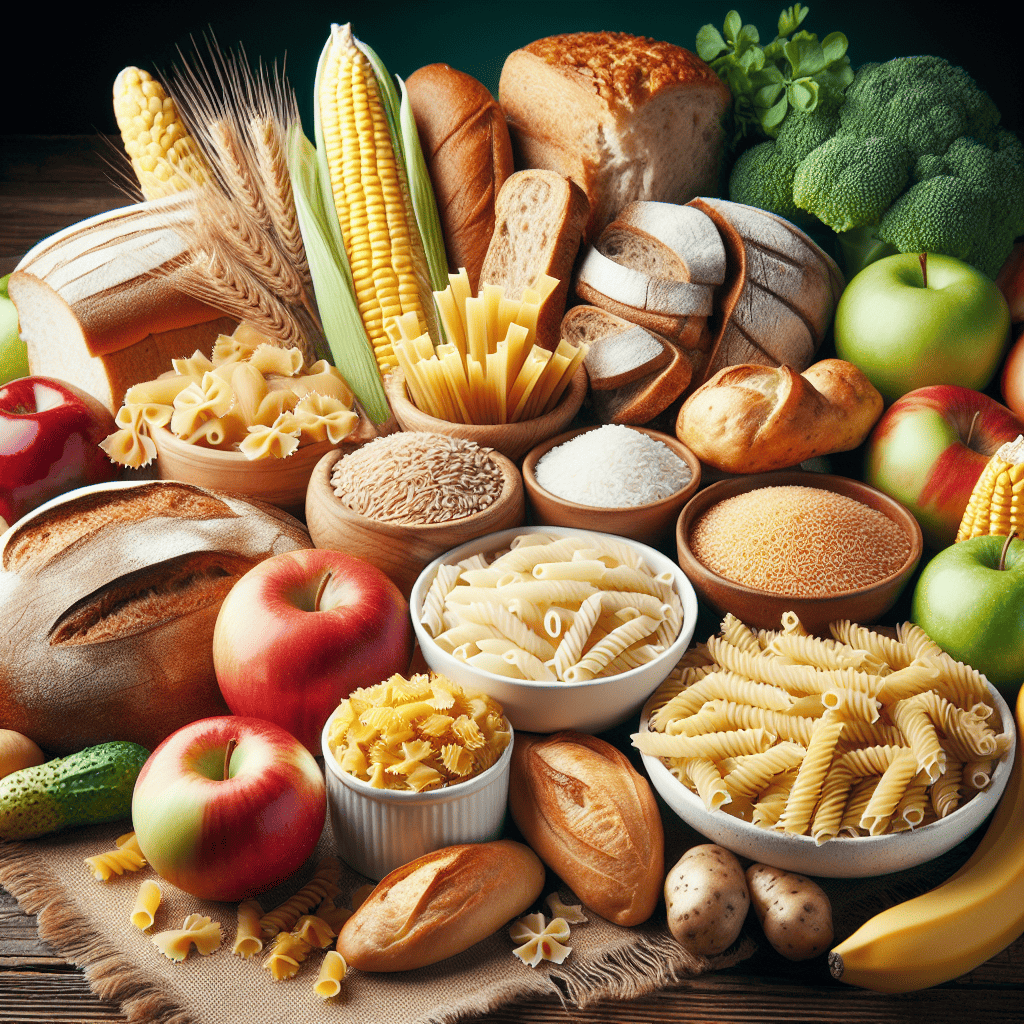Introduction: Wheat derivatives play a vital role in various cuisines and food products globally. This blog post delves into the different derivatives extracted from wheat grains, such as wheat flour, semolina, bulgur, and more, while also exploring the nutritional aspects and various types of wheat grains.
Table of Contents
Wheat Derivatives
This section covers a range of derivatives obtained from wheat grains.
- Wheat Flour:
Wheat flour is a fundamental ingredient in baking and cooking, available in different types to suit various culinary needs. All-purpose flour, the most commonly used type, is a versatile option suitable for a wide range of recipes. It is a blend of high and low gluten wheat varieties, making it ideal for baking cookies, cakes, muffins, and biscuits. All-purpose flour provides a balance between structure and tenderness in baked goods, making it a popular choice for everyday cooking.
Whole wheat flour is another type that is less processed than all-purpose flour, containing the entire wheat kernel, including bran, germ, and endosperm. This results in a higher fiber content and a nuttier flavor profile. Whole wheat flour is a nutritious option that adds a hearty texture and flavor to baked goods. It is commonly used in recipes like whole grain bread, muffins, and pancakes, providing a wholesome alternative to refined flours.
Bread flour is a type of wheat flour with a higher protein content specifically designed for making yeast breads. The extra protein strengthens the gluten structure in bread dough, resulting in a chewy and elastic texture, ideal for bread loaves with a good rise and structure. Bread flour is recommended for recipes that require a longer fermentation process, such as artisanal bread, pizza crusts, and bagels. Its high protein content gives bread a satisfying chewiness and helps create a crusty exterior. Understanding the unique properties of each type of wheat flour allows home cooks and bakers to select the most appropriate option for their culinary creations.
- Semolina:
Semolina, a coarse flour widely utilized in various culinary applications, is especially prominent in the creation of pasta, couscous, and delectable sweet puddings. Its unique texture and nutty taste make it a sought-after ingredient in the kitchen. In pasta production, semolina’s high gluten content provides the necessary elasticity for shaping different pasta varieties, resulting in a satisfying al dente texture when cooked. Similarly, in the preparation of couscous, semolina’s ability to absorb liquids while maintaining a distinct granular structure gives this North African staple its characteristic light and fluffy consistency.
Moreover, semolina’s versatility extends to the realm of desserts, where it is a key component in various sweet puddings and baked goods. The coarse nature of semolina contributes to the rich and creamy texture of desserts like semolina pudding or halva, a sweet confection popular in Middle Eastern cuisine. The nutty flavor of semolina enhances the overall taste profile of these desserts, adding a subtle depth of flavor that complements other ingredients like spices, fruits, and nuts.
The use of semolina in cooking is not only limited to its culinary attributes but also extends to its nutritional benefits. Semolina is a good source of carbohydrates, protein, and essential nutrients like iron, magnesium, and B vitamins. Its moderate glycemic index provides a sustained release of energy, making it a suitable option for maintaining blood sugar levels. Incorporating semolina into a balanced diet can offer a range of health benefits, including promoting digestive health, supporting muscle function, and aiding in overall well-being.
- Bulgur:
Bulgur is a versatile whole wheat grain that has been parboiled and dried, resulting in a quick-cooking and nutritious ingredient. Originating in the Middle East, bulgur is widely used in various cuisines around the world. It has a light, nutty flavor and a slightly chewy texture, which adds depth to dishes it is included in. Due to its minimal processing, bulgur retains more nutrients compared to refined grains, making it a healthy choice for those looking to increase their whole grain intake.
One of the key advantages of bulgur is its convenience in the kitchen. Unlike unprocessed wheat berries that require long cooking times, bulgur can be rehydrated with hot water or broth in a matter of minutes, making it ideal for quick and nutritious meals. It is a staple in Middle Eastern dishes like tabbouleh, a refreshing salad made with parsley, tomatoes, and a lemony dressing. Bulgur is also commonly used in Turkish cuisine for dishes like bulgur pilaf, where it is cooked with onions, tomatoes, and various spices to create a flavorful side dish or stuffing for vegetables.
In addition to its ease of preparation and nutty taste, bulgur offers several health benefits. It is a good source of fiber, which promotes digestive health and helps maintain a feeling of fullness. Bulgur also contains important nutrients like iron, magnesium, and B vitamins, supporting energy production and overall well-being. With its versatility in both savory and sweet dishes, bulgur is a valuable ingredient to have in your pantry for creating wholesome and satisfying meals.
- Couscous:
Couscous, a staple in North African and Middle Eastern cuisines, is a type of small pasta crafted from semolina, a coarse wheat middling. The couscous grains are made by rolling and shaping moistened semolina into tiny pellets, which are then dried. This process gives couscous its distinctive texture, with each tiny grain remaining separate and fluffy when cooked. The versatility of couscous lies in its neutral flavor profile, making it an excellent base for absorbing the flavors of accompanying ingredients such as spices, herbs, meats, vegetables, and sauces.
In terms of preparation, couscous is remarkably quick and easy to cook, requiring minimal effort and time. Traditionally, it is cooked by steaming or soaking in hot water, which allows the grains to fluff up and become tender. This rapid cooking time has made couscous a popular choice for busy households and culinary enthusiasts seeking a convenient yet tasty meal option. While instant couscous is widely available for convenience, many chefs and home cooks prefer the traditional method of steaming to achieve the desired light and airy texture.
The culinary possibilities with couscous are endless, as it can be served as a side dish, salad, or main course, depending on the ingredients and seasonings used. Commonly, couscous is paired with hearty stews, grilled meats, roasted vegetables, and tangy sauces to create a satisfying and flavorful meal. Its ability to work well with both savory and sweet dishes also makes it a versatile ingredient in the kitchen. Whether enjoyed hot or cold, couscous offers a delightful texture and mild flavor that blends harmoniously with a wide range of culinary creations.
- Macaroni:
Macaroni is a type of pasta that is popular in various dishes around the world. It is typically made from durum wheat and water, which gives it a firm texture when cooked. The hollow tube shape of macaroni is perfect for holding various types of sauces, making it a versatile choice for a wide range of recipes. One of the most famous dishes featuring macaroni is macaroni and cheese, a beloved comfort food that combines cooked macaroni with a creamy cheese sauce. This dish is often baked until golden and bubbly for a deliciously satisfying meal.
In addition to macaroni and cheese, this pasta is also commonly used in pasta salads, where its shape helps it hold dressings and other ingredients well. The sturdy nature of macaroni makes it a great choice for salads that need to hold up over time without becoming soggy. Baked pasta dishes such as macaroni casseroles are another popular way to enjoy this pasta. These dishes often feature layers of cooked macaroni with various meats, vegetables, cheeses, and sauces, creating a hearty and flavorful meal that is perfect for feeding a crowd.
Overall, macaroni is a versatile and dependable pasta that can be used in a wide range of dishes. Its unique shape and texture make it a favorite choice for both home cooks and professional chefs alike. Whether you’re craving a comforting bowl of macaroni and cheese or a refreshing pasta salad, macaroni is sure to please with its ability to hold sauces and flavors effectively. So next time you’re looking for a delicious and satisfying meal, consider incorporating macaroni into your cooking repertoire for a tasty and versatile option.
- Wheat Bran:
Wheat bran, as the outer layer of the wheat kernel, is a powerhouse of nutrients and fiber. It contains a significant amount of dietary fiber, which is essential for digestive health and regulating blood sugar levels. Consuming foods rich in fiber, like wheat bran, can aid in weight management by promoting a feeling of fullness and reducing overall calorie intake. Additionally, fiber helps to prevent constipation and promotes regular bowel movements, contributing to a healthy digestive system.
In addition to its high fiber content, wheat bran is also a good source of essential nutrients such as vitamins, minerals, and antioxidants. These nutrients play vital roles in supporting various bodily functions, including immune function, cellular repair, and energy production. Wheat bran is particularly rich in B vitamins, including thiamine, niacin, and folate, which are important for converting food into energy and maintaining a healthy nervous system. Furthermore, wheat bran contains minerals like iron, magnesium, and zinc, which are necessary for red blood cell production, muscle function, and immune system health.
When added to foods like cereals, bread, and muffins, wheat bran not only enhances their nutritional profile but also imparts a pleasant nutty flavor and a slightly crunchy texture. Incorporating wheat bran into your diet can be a simple yet effective way to increase your fiber and nutrient intake. Whether sprinkled on top of yogurt or mixed into pancake batter, wheat bran is a versatile ingredient that can be incorporated into a variety of dishes to boost their health benefits. Overall, including wheat bran in your diet can help you meet your daily fiber needs and support overall well-being.
- Freika:
Freika, commonly known as farro, is a type of ancient wheat grain that has been cultivated for centuries. It has a distinct nutty flavor and a chewy texture, making it a versatile ingredient in the culinary world. Farro is packed with nutrients, including fiber, protein, and a variety of vitamins and minerals, making it a healthy choice for those looking to add more wholesomeness to their diet.
In the kitchen, freika can be utilized in a wide range of dishes, from salads to soups and side dishes. Its robust flavor and hearty texture make it a popular choice for adding depth and richness to meals. When cooked, farro retains its chewy consistency, adding a satisfying element to any dish it is included in. Additionally, its nutritional profile makes it a great alternative to refined grains, as it is lower in calories and higher in fiber, providing a longer-lasting feeling of fullness.
Farro can be prepared in various ways to enhance its taste and texture. It can be simmered in water or broth until tender, cooked and served alongside vegetables and protein, or even toasted for a crunchy addition to salads. This ancient grain’s versatility and nutritional benefits have contributed to its resurgence in modern cuisine, appealing to health-conscious individuals and culinary enthusiasts alike. Whether used as a base for a hearty grain bowl or as an ingredient in a comforting soup, freika continues to captivate taste buds with its unique flavor and wholesome characteristics.
Definition of Wheat
This section provides an overview of the nutritional composition and characteristics of wheat.
- Nutritional Composition:
Wheat is one of the most widely consumed grains globally and is a fundamental component of many diets around the world. It provides a substantial amount of carbohydrates, which are the body’s primary source of energy. The fiber content in wheat aids in digestion and helps maintain gut health by promoting regular bowel movements and preventing constipation. Additionally, wheat contains a considerable amount of protein, making it a valuable source of this essential macronutrient for vegetarians and vegans.
Aside from its macronutrient content, wheat is also rich in various vitamins and minerals critical for the body’s proper functioning. It is a good source of B vitamins such as niacin, thiamine, and riboflavin, which play vital roles in metabolism, energy production, and nerve function. Furthermore, wheat contains minerals like iron, magnesium, and zinc, which are necessary for supporting the immune system, maintaining bone health, and promoting overall well-being. Including wheat in a balanced diet can help individuals meet their daily requirements for these essential nutrients and contribute to their overall health.
Moreover, wheat serves as a versatile ingredient that can be used in numerous culinary applications. It can be processed into various forms such as flour, pasta, bread, and breakfast cereals, offering a wide range of options for including wheat in meals. Its adaptability and widespread availability make it a convenient and affordable staple food for people in diverse regions and socio-economic backgrounds. By incorporating wheat-based products into their diet, individuals can benefit from its nutritional value and enjoy the delicious and satisfying meals that this versatile grain can help create.
- Characteristics:
Wheat grains are one of the most versatile cereal grains, widely consumed all over the world. They are a staple in many diets and can be processed into a variety of products, each with unique characteristics and culinary uses. One of the most common products derived from wheat grains is flour, which is essential for baking bread, cakes, cookies, and a wide range of other baked goods. Wheat flour comes in different varieties, including all-purpose flour, whole wheat flour, and bread flour, each suited for specific types of recipes.
In addition to flour, wheat grains can also be processed into bran, which is the outer layer of the wheat kernel. Wheat bran is a rich source of dietary fiber and nutrients, making it a popular ingredient in breakfast cereals, muffins, and other baked goods. It adds a nutty flavor and a crunchy texture to dishes, enhancing both taste and nutritional value. Another common product of wheat processing is semolina, a coarse flour that is often used in making pasta, couscous, and certain types of desserts. Semolina gives these foods a distinct texture and bite, making them more satisfying to eat.
The neutral flavor profile of wheat grains makes them incredibly versatile in the kitchen, as they can be used in a wide variety of dishes, both savory and sweet. From hearty whole wheat bread to delicate pastries, wheat grains can add depth and texture to countless recipes. Their adaptability and widespread availability make them a popular choice for home cooks and professional chefs alike. Whether you’re aiming for a comforting bowl of pasta or a light and fluffy cake, wheat grains in their various forms offer endless possibilities for culinary creativity.
Different Types of Wheat Grains
This section explores the main types of wheat grains and their specific uses.
- Hard Red Wheat:
Hard red wheat, known for its high protein content, is favored by bakers for producing a variety of baked goods such as bread, rolls, and other yeast-leavened products. This type of wheat is particularly suitable for bread-making due to its ability to create a strong gluten network. The protein in hard red wheat helps to strengthen the dough, allowing it to rise well and maintain its shape during baking. The resulting bread has a great texture and volume, perfect for making sandwiches or enjoying with spreads and toppings.
In addition to its excellent baking properties, hard red wheat is also known for its robust flavor. The wheat’s rich, nutty taste adds depth to baked goods, enhancing their overall flavor profile. This makes bread and rolls made from hard red wheat not only a filling and nutritious choice but also a delicious one. The flavor of hard red wheat adds a distinct character to the finished products, setting them apart from those made with other types of wheat. Whether used in traditional loaves of bread or artisanal rolls, hard red wheat lends a unique and pleasant taste that appeals to many consumers.
Furthermore, the gluten content in hard red wheat plays a crucial role in creating dough with excellent elasticity. Gluten is a protein that provides structure and strength to baked goods, helping them rise and hold their shape. The gluten in hard red wheat allows the dough to stretch and expand, resulting in products with a desirable chewiness and crumb structure. Bakers appreciate the quality of dough made from hard red wheat as it is easy to work with and produces consistent results. Whether kneaded by hand or using a mixer, the dough made from hard red wheat exhibits elasticity that makes shaping and forming a smooth and enjoyable process.
- Soft White Wheat:
Soft white wheat, with its lower protein and gluten content, is an ideal choice for baking delicate and tender pastries, cakes, cookies, and other baked goods. The lower protein levels mean that when the flour is mixed with liquid, it creates less gluten formation. This results in a softer and more crumbly texture, perfect for achieving the light and fluffy consistency desired in these types of treats. Additionally, the reduced gluten content ensures that the final products are not tough or chewy, but rather maintain a tender and melt-in-your-mouth quality.
Furthermore, the subtle and delicate flavor of soft white wheat enhances the overall taste of the baked goods. Its milder flavor profile allows the other ingredients in the recipe to shine through without overpowering them, making it a versatile choice for a wide range of sweet treats. Whether used in a classic cake, a flaky pastry, or a buttery cookie, soft white wheat flour works harmoniously with different flavor combinations, adding a subtle background taste that complements the overall dessert without being too dominant. This makes it a preferred option for bakers looking to create desserts that are not only visually appealing but also boast a well-balanced and delicious flavor profile.
In conclusion, soft white wheat flour’s characteristics make it a valuable ingredient for achieving the desired texture and taste in a variety of baked goods. Its lower protein content results in a more delicate and tender crumb structure, while the reduced gluten levels ensure a softer mouthfeel without the risk of toughness. Moreover, its subtle flavor allows the true essence of the dessert to shine, making it a versatile and reliable choice for bakers and pastry chefs. Whether you are whipping up a batch of cookies, crafting a decadent cake, or mastering the art of flaky pastries, soft white wheat flour provides the foundation for creating bakery-quality treats that are sure to impress even the most discerning palates.




